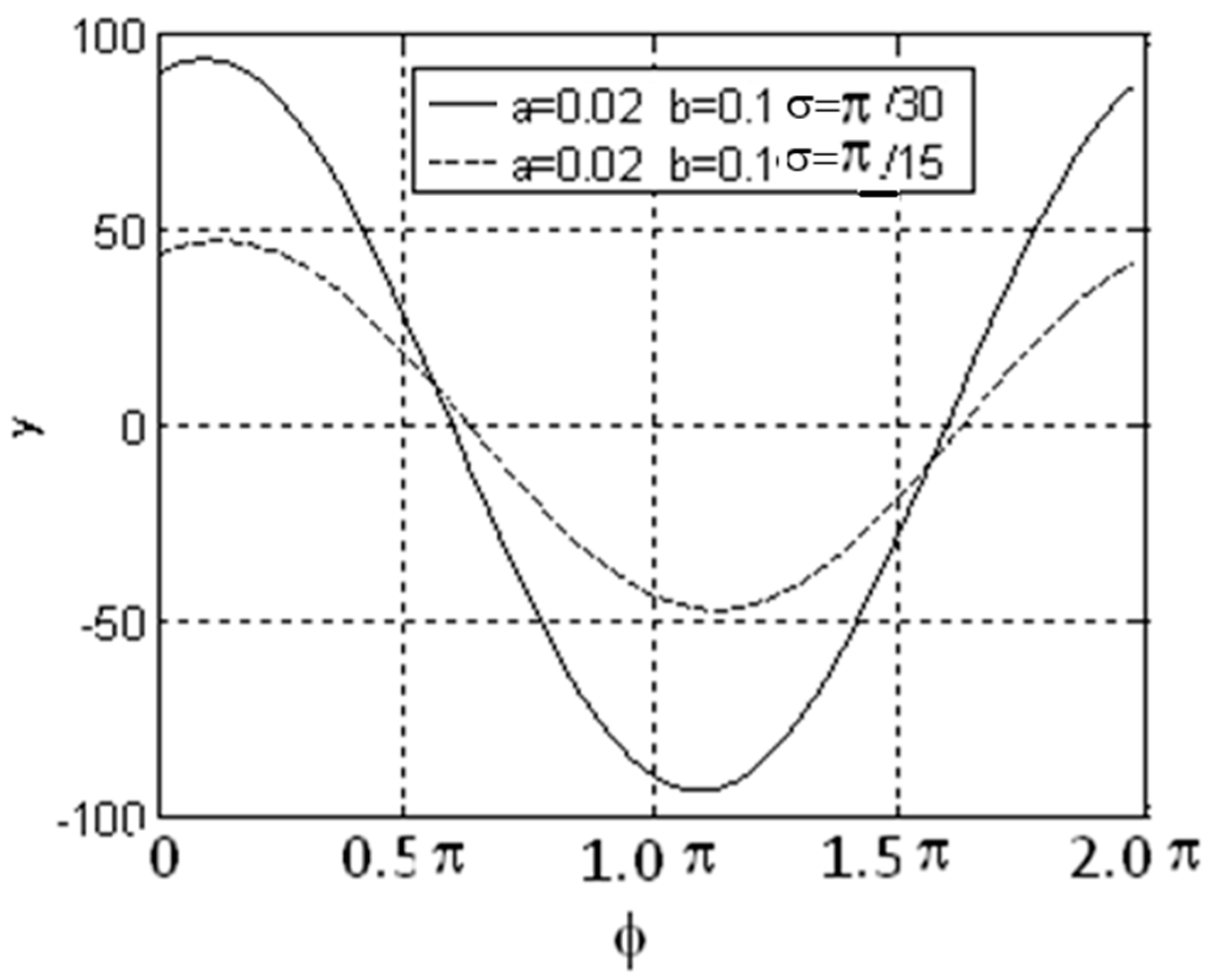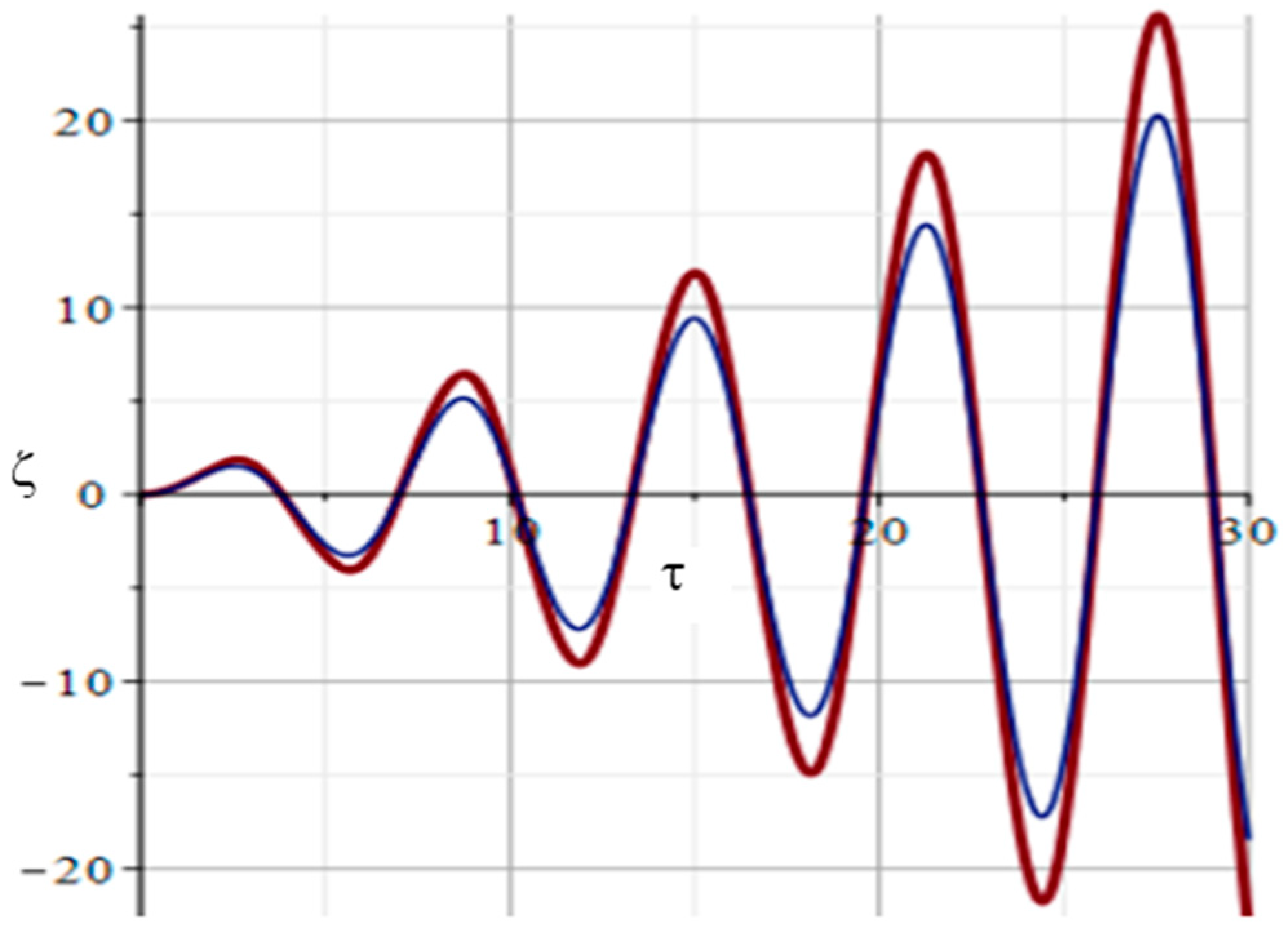Generation of Internal Gravity Waves in the Thermosphere during Operation of the SURA Facility under Parametric Resonance Conditions
Abstract
:1. Introduction
2. Problem Statement
3. Problem Solution
- exponentially decreasing cosine ,
- a segment of the cosine with frequency and duration ,
- a periodic sequence of N rectangular pulses. For certainty, we assume that their amplitudes are the same and equal to 1, and the periods coincide.
4. Numerical Estimation
5. Conclusions
- To develop a physical model of a force source and an energy source (possibly significant energy to the upper atmosphere.
- To find the relationship between the amplitude of atmospheric disturbances and the effective power of radio transmitters based on solving the nonlinear problem of waves in the atmosphere with specified localized sources. It is necessary to use a model of the medium with parameters as close as possible to those actually measured at the location of the transmitters (taking into account the wind movements of the medium that change over time and space). Such calculations probably require the use of a supercomputer.
- To analyze the possibility of solving the inverse problem: to restore the parameters of the atmosphere (possibly sources) from the measured space-time characteristics of disturbances.
Author Contributions
Funding
Acknowledgments
Conflicts of Interest
References
- Chanin, M.L.; Hauchcorne, A. Lidar observationof gravity and tidal waves in the stratosphere and mesosphere. J. Geophys. Res. 1981, 86, 9715–9721. [Google Scholar] [CrossRef]
- Gong, S.; Yang, G.; Xu, J.; Liu, X.; Li, Q. Gravity wave propagation from the stratosphere into the mesosphere studied with lidar, meteor radar, and TIMED/SABER. Atmosphere 2019, 10, 81. [Google Scholar] [CrossRef] [Green Version]
- Gavrilov, N.M.; Fukao, S.; Nakamura, T.; Tsuda, T. Statistical analysis of gravity waves observed with the middle and upper atmosphere radar in the middle atmosphere: Method and general characteristics. J. Geophys. Res. 1996, 101, 29511–29521. [Google Scholar] [CrossRef]
- Tsuda, T.; Kato, S.; Yokol, T.; Inoue, T.; Yamamoto, M.; VanZand, T.E.; Fukao, S.; Sato, T. Gravity waves in the mesosphere observed with the middle and upper atmosphere radar. Radio Sci. 1990, 26, 1005–1018. [Google Scholar] [CrossRef]
- Nakamura, T.; Tsuda, T.; Yamamoto, M.; Fukao, S.; Kato, S. Characteristics of gravity waves in the mesosphere observed with the middle and upper atmosphere radar, 1&2. J. Geophys. Res. 1993, 98, 8899–8923. [Google Scholar]
- Belikovich, V.V.; Benediktov, E.A.; Tolmacheva, A.V.; Bakhmet’eva, N.V. Ionospheric Research by Means of Artificial Periodic Irregularities; Copernicus GmbH: Katlenburg-Lindau, Germany, 2002; p. 160. [Google Scholar]
- Bakhmetieva, N.V.; Grigor’ev, G.I.; Tolmacheva, A.V. Artificial periodic irregularities, hydrodynamic instabilities, and dynamic processes in the mesosphere-lower thermosphere Radiophys. Quantum Electron. 2011, 53, 623–637. [Google Scholar] [CrossRef]
- Cai, X.; Yuan, T.; Zhao, Y.; Pautet, P.-D.; Taylor, J.; Pendleton, W.R., Jr. A coordinated investigation of the gravity wave breaking and the associated dynamical instability by a Na lidar and an Advanced Mesosphere Temperature Mapper over Logan, UT (417° N, 111.8° W). J. Geophys. Res. Space Physics. 2014, 119, 6852–6864. [Google Scholar] [CrossRef]
- Frolov, V.L.; Bakhmet’eva, N.V.; Belikovich, V.V.; Vertogradov, G.G.; Vertogradov, V.G.; Komrakov, G.P.; Kotik, D.S.; Mityakov, N.A.; Polyakov, S.V.; Rapoport, V.O.; et al. Modification of the Earth’s ionosphere by powerful short-wave radiation. Phys. Uspekhi 2007, 177, 315–324. [Google Scholar] [CrossRef]
- Belikovich, V.V.; Grach, S.M.; Karashtin, A.N.; Kotik, D.S.; Tokarev, Y.V. The SURA facility: Study of the atmosphere and space. Radiophys. Quantum Electron. 2007, 50, 497–526. [Google Scholar] [CrossRef]
- Dokuchaev, V.P.; Troitsky, V.S. Meteorological and acoustic effects of artificial heating of the troposphere by electromagnetic radiation. Docl. SSSR 1979, 248, 577–580. [Google Scholar]
- Grigoriev, G.I.; Trachtengerts, V.Y. Radiation of internal gravitational waves during the operation of powerful heating stands in the mode of time modulation of ionospheric currents. Geomagn. Aeron. 1999, 36, 758–762. [Google Scholar]
- Grigoriev, G.I.; Savina, O.N. Internal gravitational waves in an isothermal atmosphere with a variable in time by the wind. Izv. RAN FAO. 2004, 44, 41–46. [Google Scholar]
- Landau, L.D.; Lifshits, E.M. Theoretical Physics. Volume 1. Mechanics; Nauka: Moscow, Russia, 1965; 204p. [Google Scholar]
- Naife, A.H. Perturbation Methods; John Wiley & Sons: Hoboken, NJ, USA, 1973; 455p. [Google Scholar]
- Naife, A.H. Introduction to Perturbation Techniques; John Wiley & Sons: Hoboken, NJ, USA, 1984; 535p. [Google Scholar]
- Kamke, E. Handbook of Ordinary Differential Equations; Nauka: Moscow, Russia, 1965; 703p. [Google Scholar]
- Mors, F.M.; Feshbach, G. Methods of Theoretical Physics; Mc.Graw-Hill Book Co.: New York, NY, USA, 1953; Volume 1, 930p. [Google Scholar]
- Kharkevich, A.A. Spectra and Analysis; Springer: Berlin/Heidelberg, Germany, 1969; 235p. (In Russian) [Google Scholar]
- Pedlosky, J. Waves in the Ocean and Atmosphere. Introduction to Wave Dynamics; Springer: Berlin/Heidelberg, Germany, 2003; Volume VIII, 264p. [Google Scholar]
- McEwan, A.D.; Robinson, R.M. Parametric instability of internal gravity waves. J. Fluid. Mech. 1975, 67, 667–687. [Google Scholar] [CrossRef]
- Grigoriev, G.I.; Kalinina, E.E. On optimal conditions for the excitation and registration of IGWs when the upper atmosphere is heated by powerful radio emission. In Proceedings of the XXIII Scientific Conference on Radiophysics, NNGU, Nizhniy Novgorod, Russia, 15–19 April 2019; pp. 133–135. [Google Scholar]
- Chernogor, L.F.; Frolov, V.L. Features of propagation of the acoustic-gravity waves generated by high-power periodic radiation. Radiophys. Quantum Electron. 2013, 56, 197–215. [Google Scholar] [CrossRef]
- Chernogor., L.F.; Frolov, V.L. Features of the wave disturbances in the ionosphere during periodic heating of the plasma by the “Sura” radiation. Radiophys. Quantum Electron. 2013, 56, 276–289. [Google Scholar] [CrossRef]
- Tereshchenko, E.D.; Chermiakov, S.; Yurik, R.; Haggstrom, I. Total Electron Content Measurements in the Ionosphere Disturbed by High-Power High-Frequency Waves by the Methods of Incoherent Scattering of Radio Waves and Radio Sounding by Glonass Satellite Signal. Radiophys. Quantum Electron. 2020, 62. [Google Scholar] [CrossRef]
- Karpov, S.Y.; Stolyarov, S.N. Propagation and transformation of electromagnetic waves in one-dimensional periodic structures. Phys.Usp. 1993, 36, 1–22. [Google Scholar] [CrossRef]
- Elachi, C. Waves in active and passive periodic structures: A review. Proc. IEEE 1976. 64, 1666–1698. [CrossRef] [Green Version]
- Vinogradova, M.B.; Rudenko, O.V.; Sukhorukov, A.P. Wave Theory; Nauka: Moscow, Russia, 1979; 350p. (In Russian) [Google Scholar]
- Brillouin, L.; Parodi, M. Wave Propagation in Periodic Structures (International Series in Pure and Applied Physics); McGraw Hill Book Co.: New York, NY, USA, 1956; 247p. [Google Scholar]


Publisher’s Note: MDPI stays neutral with regard to jurisdictional claims in published maps and institutional affiliations. |
© 2020 by the authors. Licensee MDPI, Basel, Switzerland. This article is an open access article distributed under the terms and conditions of the Creative Commons Attribution (CC BY) license (http://creativecommons.org/licenses/by/4.0/).
Share and Cite
Grigoriev, G.I.; Lapin, V.G.; Kalinina, E.E. Generation of Internal Gravity Waves in the Thermosphere during Operation of the SURA Facility under Parametric Resonance Conditions. Atmosphere 2020, 11, 1169. https://doi.org/10.3390/atmos11111169
Grigoriev GI, Lapin VG, Kalinina EE. Generation of Internal Gravity Waves in the Thermosphere during Operation of the SURA Facility under Parametric Resonance Conditions. Atmosphere. 2020; 11(11):1169. https://doi.org/10.3390/atmos11111169
Chicago/Turabian StyleGrigoriev, Gennadiy I., Victor G. Lapin, and Elena E. Kalinina. 2020. "Generation of Internal Gravity Waves in the Thermosphere during Operation of the SURA Facility under Parametric Resonance Conditions" Atmosphere 11, no. 11: 1169. https://doi.org/10.3390/atmos11111169



